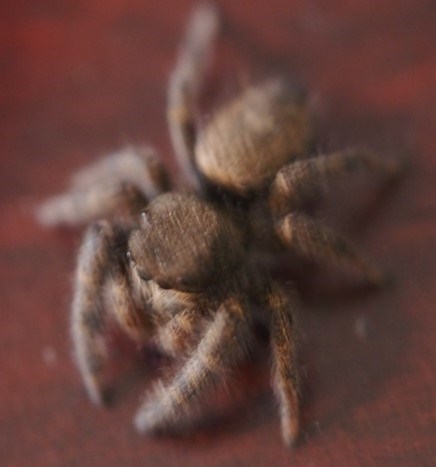Last updated: September 22, 2022
Article
Jumping Spider

NPS Photo
General Description
Jumping Spiders are members of the spider family Salticidae, the largest family of spiders with over 5,000 described species. Their body size is small to medium (although if you are arachnophobic, they probably look the size of a horse). A dense covering of iridescent scales or hairs is also typical of Jumping Spiders.Another distinguishing characteristic is the large size of their anterior median eyes (they have eight total eyes) and the patterning of their eyes.
Habitat and Ecology
Jumping Spiders are found in a variety of habitats, including vegetation, wood piles, rocky habitats, and your sock drawer. Okay, maybe or maybe not in your sock drawer – but they do like buildings as well as any other spider.They are day-time predators, using their large eyes to visually and actively hunt for small invertebrate prey, like ants and fruit flies. Because of this, they generally do not spin webs like other spiders, although they do use their silk as an anchor line for when they ambush their unsuspecting prey. They will often make a sac-like silken retreat for molting, hibernating, or simply spending the night.
The probable species (Johnson’s Jumping Spider; aka Red-Backed Jumping Spider) of this individual usually live for about one year, and cannibalism of the male during reproduction has been observed in this family.

NPS photo
Did you know?
-
Yeah, they actually do bite – but need to be provoked. The bites are painful, but not deadly.
-
With their eight eyes, they can see almost 360°. Makes it hard to sneak up on them.
-
The latin name of the probable species in the photo, Phiddipus, in Greek, means “one who spares horses.” Huh.
-
They jump. I mean, Really Jump.
-
Spiders in space. Yes, NASA sent an individual of this species into space. They called her: “Spidernaut.” Do a YouTube search on “Nefertiti the spidernaut”. Cool stuff.
Where to Find in the Klamath Network Parks
Jumping Spiders occur worldwide, except for Greenland and Antarctica. Every park in the Klamath Network will likely contain multiple species of Jumping Spiders.

NPS Photo
References and Further Reading
http://en.wikipedia.org/wiki/Phidippus. Wikipedia article on one of the most common Jumping Spider genera in North America.
Haggard, P. and J. Haggard. 2006. Insects of the Pacific Northwest. Timber Press. Portland, Oregon.
Post Script
The spider in the photos was recently adopted by the network Aquatic Ecologist, Eric Dinger, as a free-ranging office pet. Sadly, moments after these photos were taken, she disappeared. Anyone with knowledge of her whereabouts should call Eric.
